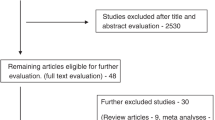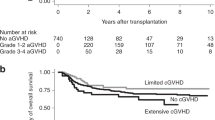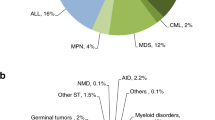Abstract
Adverse reactions (ARs) during the infusion of cellular therapy products (CTPs) are common in patients undergoing hematopoietic stem cell transplantation (HSCT). We retrospectively studied pediatric patients undergoing autologous and allogeneic HSCT to determine the incidence and grade of ARs during stem cell infusion and their predictors. We analyzed data from 213 patients (120 allogeneic and 93 autologous) who received at least 1 CTP, totaling 361 infusion episodes. Serious ARs, defined as grade 2 and 3, occurred in 25 and 11% of infusions, respectively. No grade 4 or 5 ARs were noted. Independent risk factors for developing a serious AR included stem cell source (PBSC vs marrow (odds ratio (OR) 1.8, 95% confidence interval (CI): 0.4–9); cord vs marrow (OR 7.3, 95% CI: 1.3-40), overall P=0.0001) but manipulated CTPs were protective (OR 0.4, 95% CI: 0.2-0.7, P=0.004). Unlike previous adult studies, WBC and granulocyte content were not found to be risk factors in this pediatric population. These data suggest that children tolerate higher WBC content during infusion of CTPs and support the use of manipulated CTP, as indicated, to reduce the risk of adverse infusion reactions.
This is a preview of subscription content, access via your institution
Access options
Subscribe to this journal
Receive 12 print issues and online access
$259.00 per year
only $21.58 per issue
Buy this article
- Purchase on Springer Link
- Instant access to full article PDF
Prices may be subject to local taxes which are calculated during checkout
Similar content being viewed by others
References
Davis JM, Rowley SD, Braine HG, Piantadosi S, Santos GW . Clinical toxicity of cryopreserved bone marrow graft infusion. Blood 1990; 75: 781–786.
Stroncek DF, Fautsch SK, Lasky LC, Hurd DD, Ramsay NK, McCullough J . Adverse reactions in patients transfused with cryopreserved marrow. Transfusion 1991; 31: 521–526.
Zambelli A, Poggi G, Da Prada G, Pedrazzoli P, Cuomo A, Miotti D et al. Clinical toxicity of cryopreserved circulating progenitor cells infusion. Anticancer Res 1998; 18: 4705–4708.
Zenhausern R, Tobler A, Leoncini L, Hess OM, Ferrari P . Fatal cardiac arrhythmia after infusion of dimethyl sulfoxide-cryopreserved hematopoietic stem cells in a patient with severe primary cardiac amyloidosis and end-stage renal failure. Ann Hematol 2000; 79: 523–526.
Hoyt R, Szer J, Grigg A . Neurological events associated with the infusion of cryopreserved bone marrow and/or peripheral blood progenitor cells. Bone Marrow Transplant 2000; 25: 1285–1287.
Otrock ZK, Beydoun A, Barada WM, Masroujeh R, Hourani R, Bazarbachi A . Transient global amnesia associated with the infusion of DMSO-cryopreserved autologous peripheral blood stem cells. Haematologica 2008; 93: e36–e37.
Miniero R, Vai S, Giacchino M, Giubellino C, Madon E . Severe respiratory depression after autologous bone marrow infusion. Haematologica 1992; 77: 98–99.
Sanchez-Salinas A, Cabanas-Perianes V, Blanquer M, Majado MJ, Insausti CL, Monserrat J et al. An automatic wash method for dimethyl sulfoxide removal in autologous hematopoietic stem cell transplantation decreases the adverse effects related to infusion. Transfusion 2012; 52: 2382–2386.
Shu Z, Heimfeld S, Gao D . Hematopoietic SCT with cryopreserved grafts: adverse reactions after transplantation and cryoprotectant removal before infusion. Bone Marrow Transplant 2014; 49: 469–476.
Rowley SD, Feng Z, Yadock D, Holmberg L, Macleod B, Heimfeld S . Post-thaw removal of DMSO does not completely abrogate infusional toxicity or the need for pre-infusion histamine blockade. Cytotherapy 1999; 1: 439–446.
Barker JN, Abboud M, Rice RD, Hawke R, Schaible A, Heller G et al. A "no-wash" albumin-dextran dilution strategy for cord blood unit thaw: high rate of engraftment and a low incidence of serious infusion reactions. Biol Blood Marrow Transplant 2009; 15: 1596–1602.
Calmels B, Lemarie C, Esterni B, Malugani C, Charbonnier A, Coso D et al. Occurrence and severity of adverse events after autologous hematopoietic progenitor cell infusion are related to the amount of granulocytes in the apheresis product. Transfusion 2007; 47: 1268–1275.
Milone G, Mercurio S, Strano A, Leotta S, Pinto V, Battiato K et al. Adverse events after infusions of cryopreserved hematopoietic stem cells depend on non-mononuclear cells in the infused suspension and patient age. Cytotherapy 2007; 9: 348–355.
Mulay SB, Greiner CW, Mohr A, Bryant SC, Lingineni RK, Padley D et al. Infusion technique of hematopoietic progenitor cells and related adverse events (CME). Transfusion 2014; 54: 1997–2003.
Richa E . The correlation between the granulocyte content in infused stem cells and side effects of the infusion. Blood Transfus 2011; 9: 346.
Donmez A, Tombuloglu M, Gungor A, Soyer N, Saydam G, Cagirgan S . Clinical side effects during peripheral blood progenitor cell infusion. Transfus Apher Sci 2007; 36: 95–101.
Khera N, Jinneman J, Storer BE, Heimfeld S, O'Meara MM, Chauncey TR et al. Limiting the daily total nucleated cell dose of cryopreserved peripheral blood stem cell products for autologous transplantation improves infusion-related safety with no adverse impact on hematopoietic engraftment. Biol Blood Marrow Transplant 2012; 18: 220–228.
Alessandrino P, Bernasconi P, Caldera D, Colombo A, Bonfichi M, Malcovati L et al. Adverse events occurring during bone marrow or peripheral blood progenitor cell infusion: analysis of 126 cases. Bone Marrow Transplant 1999; 23: 533–537.
Cordoba R, Arrieta R, Kerguelen A, Hernandez-Navarro F . The occurrence of adverse events during the infusion of autologous peripheral blood stem cells is related to the number of granulocytes in the leukapheresis product. Bone Marrow Transplant 2007; 40: 1063–1067.
Rubinstein P, Dobrila L, Rosenfield RE, Adamson JW, Migliaccio G, Migliaccio AR et al. Processing and cryopreservation of placental/umbilical cord blood for unrelated bone marrow reconstitution. Proc Natl Acad Sci USA 1995; 92: 10119–10122.
Bear AS, Hanley PJ, Bosque DM, Cruz CR, Kaur I, Liu H et al. Low rate of infusional toxicity after expanded cord blood transplantation. Cytotherapy 2014; 16: 1153–1157.
Morris C, de Wreede L, Scholten M, Brand R, van Biezen A, Sureda A et al. Should the standard dimethyl sulfoxide concentration be reduced? Results of a European Group for Blood and Marrow Transplantation prospective noninterventional study on usage and side effects of dimethyl sulfoxide. Transfusion 2014; 54: 2514–2522.
Regan DM, Wofford JD, Wall DA . Comparison of cord blood thawing methods on cell recovery, potency, and infusion. Transfusion 2010; 50: 2670–2675.
Akel S, Regan D, Wall D, Petz L, McCullough J . Current thawing and infusion practice of cryopreserved cord blood: the impact on graft quality, recipient safety, and transplantation outcomes. Transfusion 2014; 54: 2997–3009.
Santos NC, Figueira-Coelho J, Martins-Silva J, Saldanha C . Multidisciplinary utilization of dimethyl sulfoxide: pharmacological, cellular, and molecular aspects. Biochem Pharmacol 2003; 65: 1035–1041.
Bachier C, Potter J, Potter G, Sugay R, Shaughnessy P, Chan K et al. High white blood cell concentration in the peripheral blood stem cell product can induce seizures during infusion of autologous peripheral blood stem cells. Biol Blood Marrow Transplant 2012; 18: 1055–1060.
Okamoto Y, Takaue Y, Saito S, Shimizu T, Suzue T, Abe T et al. Toxicities associated with cryopreserved and thawed peripheral blood stem cell autografts in children with active cancer. Transfusion 1993; 33: 578–581.
Thome S, Craze J, Mitchell C . Dimethylsulphoxide-induced serum hyperosmolality after cryopreserved stem-cell graft. Lancet 1994; 344: 1431–1432.
Acknowledgements
The authors acknowledge the funding support of the Section of Pediatric Oncology/BMT, Department of Oncology, for this project.
Author information
Authors and Affiliations
Corresponding author
Ethics declarations
Competing interests
The authors declare no conflict of interest.
Rights and permissions
About this article
Cite this article
Truong, T., Moorjani, R., Dewey, D. et al. Adverse reactions during stem cell infusion in children treated with autologous and allogeneic stem cell transplantation. Bone Marrow Transplant 51, 680–686 (2016). https://doi.org/10.1038/bmt.2015.331
Received:
Revised:
Accepted:
Published:
Issue Date:
DOI: https://doi.org/10.1038/bmt.2015.331
This article is cited by
-
Management guidelines for paediatric patients receiving chimeric antigen receptor T cell therapy
Nature Reviews Clinical Oncology (2019)
-
CGRP gene-modified rBMSCs show better osteogenic differentiation capacity in vitro
Journal of Molecular Histology (2018)



